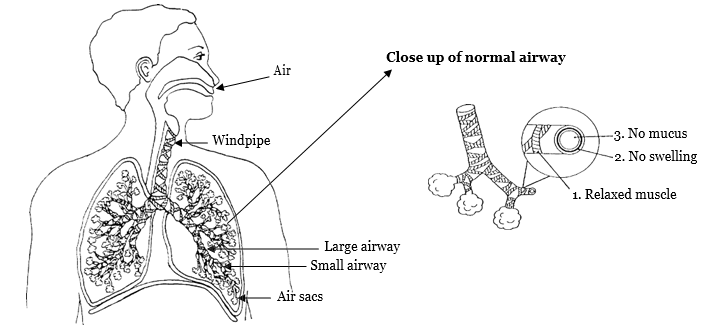Asthma
Asthma is a chronic (long term) disease of the lungs. Even when you have no symptoms, you still have asthma. This is due to chronic inflammation in the airways of your lungs. It is important to follow your Asthma Action Plan to control your asthma.
Normal breathing

Asthma episode or flare-up
During an asthma episode:
- The muscles around the airways tighten, making the airways
- The lining of the airways becomes swollen and more inflamed.
- Thick mucus forms, blocking small
These changes make it hard for air to move in and out of the lungs. You may have one or all the following symptoms:
- Coughing
- Wheezing
- Shortness of breath
- Chest tightness
What causes asthma episodes?
Things that cause asthma episodes are called triggers. Each person may have different triggers. Triggers can be colds, smoke, allergies, weather, or exercise. It is important to learn what your triggers are so that you can avoid them.
How to treat asthma episodes
You will work with your doctor to develop an Asthma Action Plan. Your Asthma Action Plan is a plan for how to manage your asthma on a daily basis as well as what to do when your asthma gets worse.
Your plan will include:
- Triggers and how to avoid them
- Medicine to take every day (Green Zone)
- Early warning signs of an asthma episode and how to treat it (Yellow Zone)
- When to call the doctor (Red Zone)
Asthma Medicines
There are two main types of medicine: rescue (or quick relief/reliever) medicine and controller (or preventive) medicine.
Rescue/reliever medicines include bronchodilators (albuterol) and steroids (liquids or pills).
- Bronchodilators work by relaxing the muscles around the airways so air can move in and out easier. They are used during an asthma episode to relieve coughing, wheezing, and shortness of breath. You should start these at the first sign of a cold. This medicine will be listed in the yellow zone of your asthma action plan. If exercise is one of your triggers, you may also be instructed to use this medicine 10-15 minutes before exercise to prevent coughing and/or shortness of breath during exercise.
- Steroids work by decreasing swelling and mucus inside the airways. They start to work in about 6-12 hours and are taken during an asthma episode when the rescue medicine alone is not helping. This medicine will be listed in the red zone of your asthma action plan. Take this medicine with food to help prevent side effects. The goal is to need this medicine no more than two times per year.
Controller medicines include inhaled steroids and leukotrienes.
- Inhaled steroids work by reducing swelling, inflammation, and mucus. They are not the same as muscle-building steroids, and they are safe to use every day. Because they are inhaled into the lungs (and not swallowed), they have fewer side effects than the oral steroid medicine. If they are part of your asthma action plan, they will be listed in the green zone. They must be taken every day, even when you are healthy, to control your asthma and prevent asthma episodes. Use a spacer with your inhaler and rinse and spit after using this medicine to prevent side effects.
-
Leukotrienes (such as montelukast or singulair) work by reducing swelling and mucus. If they are part of your asthma action plan, they will be listed in the green zone. They must be taken every day, even when you are healthy, to control your asthma and prevent asthma episodes. This medicine is a pill and should be taken in the evening. Changes in behavior or mood are a possible side effect; let your child’s doctor know if this happens.
Asthma Action Plan
Green zone means: I feel good and have no symptoms.
- Take your controller medicine every day
Yellow zone means: I do not feel good. You may have early warning signs such as cough with cold.
- Start your rescue medicine now
Red zone means: I feel awful. You may be coughing all the time and have a hard time breathing.
- Take these medicines now and call your doctor.
- Call 911 if you are worried about getting through the next 30 minutes.
How do I know if my asthma is under control?
The goal is to be in the Green Zone. Your asthma is under control if you can:
- Sleep all night
- Not cough or wheeze during the day or at night
- Be active
- Not miss school or work
Follow-up care:
See your doctor every 6 months, or more often as directed by your medical provider.
- Follow your asthma action plan
- Have refills for your medicine (don’t run out)
- Have a rescue inhaler at home and at school/daycare.
- Keep your medicine in sight and work it into your daily routine so you remember to take it.
- Share your asthma plan with school and daycare
Questions?
This sheet is not specific to your child, but it provides general information. If you have any questions, please call the clinic. We recommend that you and your child attend an asthma education program to learn more ways to control asthma. Ask your doctor, nurse, or the American Lung Association for information about available programs.
This page is not specific to your child, but provides general information on the topic above. If you have any questions, please call your clinic. For more reading material about this and other health topics, please call or visit Children's Minnesota Family Resource Center library, or visit www.childrensmn.org/educationmaterials.
© 2024 Children's Minnesota
